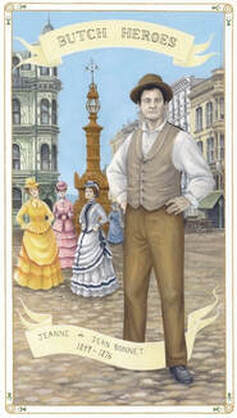About UsCrime of the Month Jeanne Bonnet, The little Frog Catcher Jeanne Bonnet a 19th century transsexual pioneer would find todays sexual identity struggles disturbingly familiar. Jeanne was born into a family of French actors. She was a very popular performer, often playing the role of a young coquette on the stage. Then tragedy struck; her mother passed away, her sister was committed to an insane asylum where she died, and her father, emotionally and physically shattered, moved to Oakland. |
By her teenage years Jeanne “cursed the day she was born a female and not a male” and altered her sexual orientation, which shifts the pronouns in the rest of this story to male. He cut his hair short, wore men’s clothes and became the leader of gang of young criminals. His gang was quickly caught and Jeanne was sent to a reformatory, called The Industrial School, located at what is now the City College’s main campus. Although Bonnet was put in the girl’s side of the school, Jeanne often went into the boys dormitory and attacked the largest boy to prove his dominance.
Upon his release Jeanne chose an unusual but profitable trade, frog catching. In the 1850s the French were the largest minority group in San Francisco, with over 30,000 people. Known as “the Paris of the West,” San Francisco claimed more French restaurants than any other city in the world besides Paris. And what is a French restaurant without Cuisses de Grenouilles (Frogs Legs) ? Jeanne hunted the waters of Lake Merced luring long legged amphibiens to their tasty doom,
pan fried, covered in clarified butter , lemon juice, and garlic .
Jeanne’s outfit violated the law, which said that people must dress in the clothing of their sex at birth and he was often arrested for wearing pants. Jeanne was also arrested for drinking and fighting, primarily with French pimps, his arch nemesis. Jeanne made it his business to rescue French prostitutes from their exploitive procurers and make them his own. He taught them a new trade, larceny, to replace their former source of income. The angry pimps threatened Jeanne, who carried a gun for protection.
On September 15th 1876 Jeanne was watching his latest rescue, Blanche Beunon, disrobe. They were in a bedroom in McNamara's Hotel, located at what is now Sickles St and San Jose Avenue, then a sleepy outpost located at the edge of the city. As Blanche bent over to take off her stockings a shotgun blast came through the window. “ I am shot Blanche” gasped Jeanne Bonnet,” the end has come, I go to meet my sister,” Then she died. The assassin escaped, unseen.
It was a challenging case with many questions. Was it Blanche or was it Jeanne who was the killer’s target? Blanche’s pimp, Arthur Deneve had threatened both women after Blanche had left him for Jeanne. After these threats Jeanne arranged for Blanche to stay with a Frenchman named Pierre Louis and his wife Caroline at a farm near McNamara’s Hotel. But police learned that Arthur had left for France days before the shooting. With the leading suspect cleared, the case went nowhere.
Suddenly the police got a break. Captain of Detectives Isaiah Lees learned that a Pacific Street saloonkeeper knew the identity of the killer. Under pressure the bartender said that Pierre Louis, the man who had given Blanche shelter, was the killer. He claimed that Arthur Deneve had offered Louis $2,000 to kill Blanche as an example to the other girls, but when Blanche bent down to take off her stockings the shots went over her head and killed Jeanne. Lees and his detectives hastened to Pierre’s farm but he and his wife Caroline had disappeared.
Later, another conspirator emerged. Blanche had another lover, a prosperous Italian merchant. He knew of her background but showered her with gifts and offered his hand in marriage if she remained faithful only to him.
When the merchant learned that she had taken up with Jeanne Bonnet he was furious. It was he who paid Pierre Louis to kill Blanche.
There was a third theory, that Pierre’ target was in fact Jeanne Bonnet and that he was paid by the French Pimps, who threw a big party in Alameda to celebrate after Jeanne’s death.
In late 1879 Captain Lees received a letter from Pierre ’s wife Carolyn in Canada. She confirmed that Pierre was the murderer and revealed his address, saying she was afraid he was going to kill her. Lees rushed up to Canada but found that Pierre had hung himself the day before.
So in the end, the crime remained officially unsolved, Blanche went back to her Italian merchant and the frogs relaxed again in Lake Merced.
